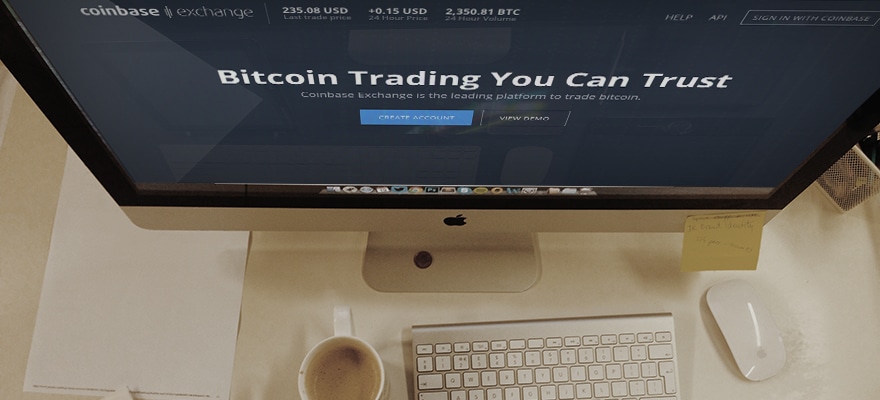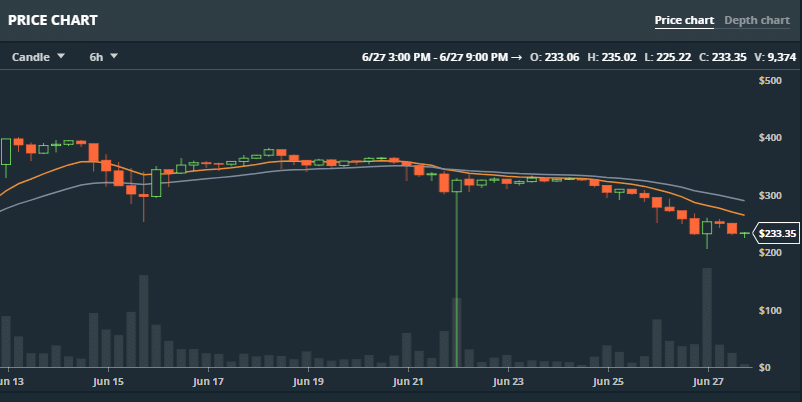Coinbase to Reimburse GDAX Traders Who Suffered at Ethereum Flash Crash
- Affected GDAX customers who got margin calls or stop loss orders executed will be credited back.

Last week someone with a massive holding of Ethereum Ethereum Ethereum is an open source, blockchain-based distributed computing platform and operating system featuring smart contract functionality. Created in 2014, Ethereum now stands as the second largest cryptocurrency by market cap at the time of writing.As a decentralized cryptocurrency network and software platform, Ethereum represents the most prominent altcoin. Ethereum also enables the creation Distributed Applications, or dapps. Understanding EthereumEthereum boasts its own programming language, called Turing Complete, which is used to build the dapps. Dapps run on a peer-to-peer (P2P0 network of virtual machines. These can be just about anything and are optimized to run on Smart Contracts. Smart Contracts are pieces of code that execute a predetermined set of actions once a certain set of criteria are met. The Ethereum network’s native currency is called Ether, or ETH. ETH tokens can be used to pay for things inside of dapps or to receive payouts from smart contracts. They can also be traded off of the Ethereum network inside of cryptocurrency exchanges or OTC trading platforms. For most of its lifetime, Ethereum has remained as the second-largest and most popular cryptocurrency in terms of its market cap. It was briefly outpaced by Bitcoin Cash near the end of 2017.Ethereum’s origin dates back to late 2013 when crypto researcher and programmer Vitalik Buterin proposed its utility.Its development was subsequently funded by an online crowdsale that took place in the middle of 2014 before going live in July 2015. At its inception, Ethereum went live with 72 million coins minted, accounting for approximately 65 percent of its total circulating supply as of May 2020.Like other cryptos, Ethereum has had a checkered past, resulting in splits. Back in 2016, an exploited vulnerability in The DAO project's smart contract software caused the theft of $50 million worth of ether.As a result, Ethereum was split into two separate blockchains – a newer and separate version became known as Ethereum (ETH), while the original chain continued to be known as Ethereum Classic (ETC). Ethereum is an open source, blockchain-based distributed computing platform and operating system featuring smart contract functionality. Created in 2014, Ethereum now stands as the second largest cryptocurrency by market cap at the time of writing.As a decentralized cryptocurrency network and software platform, Ethereum represents the most prominent altcoin. Ethereum also enables the creation Distributed Applications, or dapps. Understanding EthereumEthereum boasts its own programming language, called Turing Complete, which is used to build the dapps. Dapps run on a peer-to-peer (P2P0 network of virtual machines. These can be just about anything and are optimized to run on Smart Contracts. Smart Contracts are pieces of code that execute a predetermined set of actions once a certain set of criteria are met. The Ethereum network’s native currency is called Ether, or ETH. ETH tokens can be used to pay for things inside of dapps or to receive payouts from smart contracts. They can also be traded off of the Ethereum network inside of cryptocurrency exchanges or OTC trading platforms. For most of its lifetime, Ethereum has remained as the second-largest and most popular cryptocurrency in terms of its market cap. It was briefly outpaced by Bitcoin Cash near the end of 2017.Ethereum’s origin dates back to late 2013 when crypto researcher and programmer Vitalik Buterin proposed its utility.Its development was subsequently funded by an online crowdsale that took place in the middle of 2014 before going live in July 2015. At its inception, Ethereum went live with 72 million coins minted, accounting for approximately 65 percent of its total circulating supply as of May 2020.Like other cryptos, Ethereum has had a checkered past, resulting in splits. Back in 2016, an exploited vulnerability in The DAO project's smart contract software caused the theft of $50 million worth of ether.As a result, Ethereum was split into two separate blockchains – a newer and separate version became known as Ethereum (ETH), while the original chain continued to be known as Ethereum Classic (ETC). Read this Term cashed out on GDAX, the institutional Exchange Exchange An exchange is known as a marketplace that supports the trading of derivatives, commodities, securities, and other financial instruments.Generally, an exchange is accessible through a digital platform or sometimes at a tangible address where investors organize to perform trading. Among the chief responsibilities of an exchange would be to uphold honest and fair-trading practices. These are instrumental in making sure that the distribution of supported security rates on that exchange are effectively relevant with real-time pricing.Depending upon where you reside, an exchange may be referred to as a bourse or a share exchange while, as a whole, exchanges are present within the majority of countries. Who is Listed on an Exchange?As trading continues to transition more to electronic exchanges, transactions become more dispersed through varying exchanges. This in turn has caused a surge in the implementation of trading algorithms and high-frequency trading applications. In order for a company to be listed on a stock exchange for example, a company must divulge information such as minimum capital requirements, audited earnings reports, and financial reports.Not all exchanges are created equally, with some outperforming other exchanges significantly. The most high-profile exchanges to date include the New York Stock Exchange (NYSE), the Tokyo Stock Exchange (TSE), the London Stock Exchange (LSE), and the Nasdaq. Outside of trading, a stock exchange may be used by companies aiming to raise capital, this is most commonly seen in the form of initial public offerings (IPOs).Exchanges can now handle other asset classes, given the rise of cryptocurrencies as a more popularized form of trading. An exchange is known as a marketplace that supports the trading of derivatives, commodities, securities, and other financial instruments.Generally, an exchange is accessible through a digital platform or sometimes at a tangible address where investors organize to perform trading. Among the chief responsibilities of an exchange would be to uphold honest and fair-trading practices. These are instrumental in making sure that the distribution of supported security rates on that exchange are effectively relevant with real-time pricing.Depending upon where you reside, an exchange may be referred to as a bourse or a share exchange while, as a whole, exchanges are present within the majority of countries. Who is Listed on an Exchange?As trading continues to transition more to electronic exchanges, transactions become more dispersed through varying exchanges. This in turn has caused a surge in the implementation of trading algorithms and high-frequency trading applications. In order for a company to be listed on a stock exchange for example, a company must divulge information such as minimum capital requirements, audited earnings reports, and financial reports.Not all exchanges are created equally, with some outperforming other exchanges significantly. The most high-profile exchanges to date include the New York Stock Exchange (NYSE), the Tokyo Stock Exchange (TSE), the London Stock Exchange (LSE), and the Nasdaq. Outside of trading, a stock exchange may be used by companies aiming to raise capital, this is most commonly seen in the form of initial public offerings (IPOs).Exchanges can now handle other asset classes, given the rise of cryptocurrencies as a more popularized form of trading. Read this Term of platform of Coinbase, leading the ETH market to temporarily trade as low as $0.10 whipping out many margin traders. After first announcing that "these trades are final," Coinbase has reversed course and decided to reimburse those affected.
The London Summit 2017 is coming, get involved!

Adam White, Head of GDAX, explained the situation:
“GDAX is just over two years old and has grown to become one of the world’s leading digital asset exchanges. We launched our first version of margin trading earlier this year and have generally seen strong customer demand and positive feedback.

Our long-term ambition, however, is to be a leader among all exchange platforms and we are committed to serving as the most trusted provider to the world’s largest institutions and professional traders. We are confident that all trades this week were executed properly, however, some customers did not receive the quality of service we strive to provide and we want to do better.
We will establish a process to credit customer accounts which experienced a margin call or stop loss order executed on the GDAX ETH-USD order book as a direct result of the rapid price movement at 12.30pm PT on June 21, 2017. This process will allow affected customers to restore the value of their ETH-USD account to the equivalent value of their ETH-USD account at the moment prior to the rapid price movement.
To clarify:
For customers who had buy orders filled — we are honoring all executed orders and no trades will be reversed.
For affected customers who had margin calls or stop loss orders executed — we are crediting you using company funds.
We view this as an opportunity to demonstrate our long-term commitment to our customers and belief in the future of this industry.”
Last week someone with a massive holding of Ethereum Ethereum Ethereum is an open source, blockchain-based distributed computing platform and operating system featuring smart contract functionality. Created in 2014, Ethereum now stands as the second largest cryptocurrency by market cap at the time of writing.As a decentralized cryptocurrency network and software platform, Ethereum represents the most prominent altcoin. Ethereum also enables the creation Distributed Applications, or dapps. Understanding EthereumEthereum boasts its own programming language, called Turing Complete, which is used to build the dapps. Dapps run on a peer-to-peer (P2P0 network of virtual machines. These can be just about anything and are optimized to run on Smart Contracts. Smart Contracts are pieces of code that execute a predetermined set of actions once a certain set of criteria are met. The Ethereum network’s native currency is called Ether, or ETH. ETH tokens can be used to pay for things inside of dapps or to receive payouts from smart contracts. They can also be traded off of the Ethereum network inside of cryptocurrency exchanges or OTC trading platforms. For most of its lifetime, Ethereum has remained as the second-largest and most popular cryptocurrency in terms of its market cap. It was briefly outpaced by Bitcoin Cash near the end of 2017.Ethereum’s origin dates back to late 2013 when crypto researcher and programmer Vitalik Buterin proposed its utility.Its development was subsequently funded by an online crowdsale that took place in the middle of 2014 before going live in July 2015. At its inception, Ethereum went live with 72 million coins minted, accounting for approximately 65 percent of its total circulating supply as of May 2020.Like other cryptos, Ethereum has had a checkered past, resulting in splits. Back in 2016, an exploited vulnerability in The DAO project's smart contract software caused the theft of $50 million worth of ether.As a result, Ethereum was split into two separate blockchains – a newer and separate version became known as Ethereum (ETH), while the original chain continued to be known as Ethereum Classic (ETC). Ethereum is an open source, blockchain-based distributed computing platform and operating system featuring smart contract functionality. Created in 2014, Ethereum now stands as the second largest cryptocurrency by market cap at the time of writing.As a decentralized cryptocurrency network and software platform, Ethereum represents the most prominent altcoin. Ethereum also enables the creation Distributed Applications, or dapps. Understanding EthereumEthereum boasts its own programming language, called Turing Complete, which is used to build the dapps. Dapps run on a peer-to-peer (P2P0 network of virtual machines. These can be just about anything and are optimized to run on Smart Contracts. Smart Contracts are pieces of code that execute a predetermined set of actions once a certain set of criteria are met. The Ethereum network’s native currency is called Ether, or ETH. ETH tokens can be used to pay for things inside of dapps or to receive payouts from smart contracts. They can also be traded off of the Ethereum network inside of cryptocurrency exchanges or OTC trading platforms. For most of its lifetime, Ethereum has remained as the second-largest and most popular cryptocurrency in terms of its market cap. It was briefly outpaced by Bitcoin Cash near the end of 2017.Ethereum’s origin dates back to late 2013 when crypto researcher and programmer Vitalik Buterin proposed its utility.Its development was subsequently funded by an online crowdsale that took place in the middle of 2014 before going live in July 2015. At its inception, Ethereum went live with 72 million coins minted, accounting for approximately 65 percent of its total circulating supply as of May 2020.Like other cryptos, Ethereum has had a checkered past, resulting in splits. Back in 2016, an exploited vulnerability in The DAO project's smart contract software caused the theft of $50 million worth of ether.As a result, Ethereum was split into two separate blockchains – a newer and separate version became known as Ethereum (ETH), while the original chain continued to be known as Ethereum Classic (ETC). Read this Term cashed out on GDAX, the institutional Exchange Exchange An exchange is known as a marketplace that supports the trading of derivatives, commodities, securities, and other financial instruments.Generally, an exchange is accessible through a digital platform or sometimes at a tangible address where investors organize to perform trading. Among the chief responsibilities of an exchange would be to uphold honest and fair-trading practices. These are instrumental in making sure that the distribution of supported security rates on that exchange are effectively relevant with real-time pricing.Depending upon where you reside, an exchange may be referred to as a bourse or a share exchange while, as a whole, exchanges are present within the majority of countries. Who is Listed on an Exchange?As trading continues to transition more to electronic exchanges, transactions become more dispersed through varying exchanges. This in turn has caused a surge in the implementation of trading algorithms and high-frequency trading applications. In order for a company to be listed on a stock exchange for example, a company must divulge information such as minimum capital requirements, audited earnings reports, and financial reports.Not all exchanges are created equally, with some outperforming other exchanges significantly. The most high-profile exchanges to date include the New York Stock Exchange (NYSE), the Tokyo Stock Exchange (TSE), the London Stock Exchange (LSE), and the Nasdaq. Outside of trading, a stock exchange may be used by companies aiming to raise capital, this is most commonly seen in the form of initial public offerings (IPOs).Exchanges can now handle other asset classes, given the rise of cryptocurrencies as a more popularized form of trading. An exchange is known as a marketplace that supports the trading of derivatives, commodities, securities, and other financial instruments.Generally, an exchange is accessible through a digital platform or sometimes at a tangible address where investors organize to perform trading. Among the chief responsibilities of an exchange would be to uphold honest and fair-trading practices. These are instrumental in making sure that the distribution of supported security rates on that exchange are effectively relevant with real-time pricing.Depending upon where you reside, an exchange may be referred to as a bourse or a share exchange while, as a whole, exchanges are present within the majority of countries. Who is Listed on an Exchange?As trading continues to transition more to electronic exchanges, transactions become more dispersed through varying exchanges. This in turn has caused a surge in the implementation of trading algorithms and high-frequency trading applications. In order for a company to be listed on a stock exchange for example, a company must divulge information such as minimum capital requirements, audited earnings reports, and financial reports.Not all exchanges are created equally, with some outperforming other exchanges significantly. The most high-profile exchanges to date include the New York Stock Exchange (NYSE), the Tokyo Stock Exchange (TSE), the London Stock Exchange (LSE), and the Nasdaq. Outside of trading, a stock exchange may be used by companies aiming to raise capital, this is most commonly seen in the form of initial public offerings (IPOs).Exchanges can now handle other asset classes, given the rise of cryptocurrencies as a more popularized form of trading. Read this Term of platform of Coinbase, leading the ETH market to temporarily trade as low as $0.10 whipping out many margin traders. After first announcing that "these trades are final," Coinbase has reversed course and decided to reimburse those affected.
The London Summit 2017 is coming, get involved!

Adam White, Head of GDAX, explained the situation:
“GDAX is just over two years old and has grown to become one of the world’s leading digital asset exchanges. We launched our first version of margin trading earlier this year and have generally seen strong customer demand and positive feedback.

Our long-term ambition, however, is to be a leader among all exchange platforms and we are committed to serving as the most trusted provider to the world’s largest institutions and professional traders. We are confident that all trades this week were executed properly, however, some customers did not receive the quality of service we strive to provide and we want to do better.
We will establish a process to credit customer accounts which experienced a margin call or stop loss order executed on the GDAX ETH-USD order book as a direct result of the rapid price movement at 12.30pm PT on June 21, 2017. This process will allow affected customers to restore the value of their ETH-USD account to the equivalent value of their ETH-USD account at the moment prior to the rapid price movement.
To clarify:
For customers who had buy orders filled — we are honoring all executed orders and no trades will be reversed.
For affected customers who had margin calls or stop loss orders executed — we are crediting you using company funds.
We view this as an opportunity to demonstrate our long-term commitment to our customers and belief in the future of this industry.”
